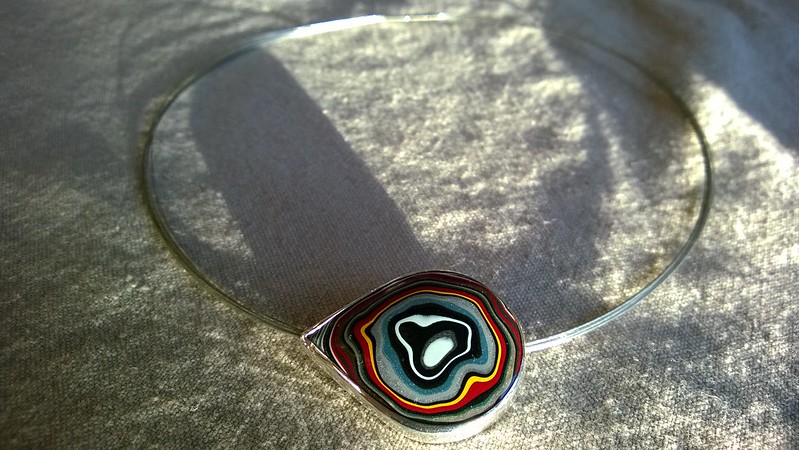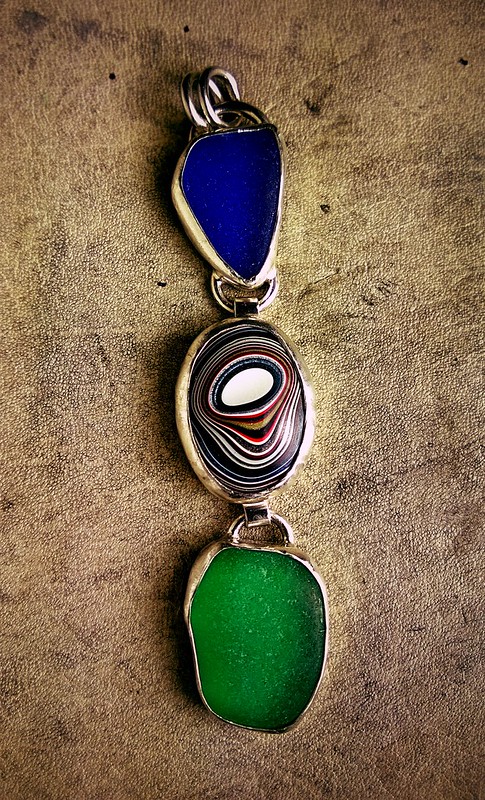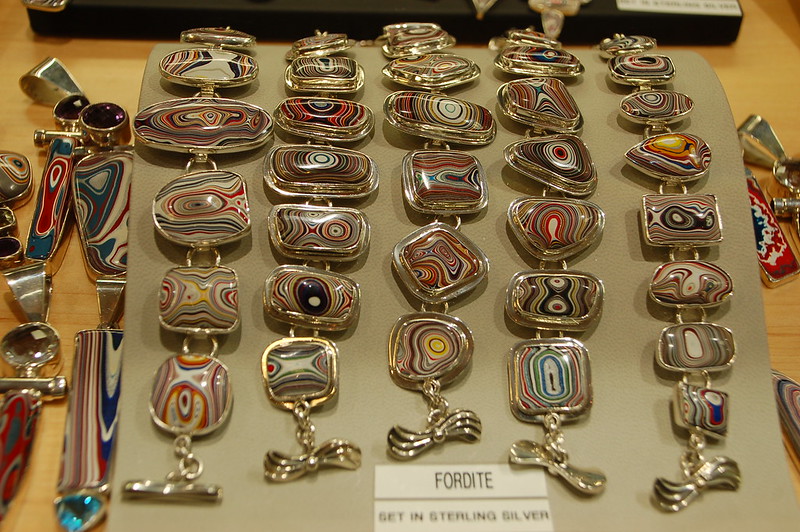Fordite has a certain appeal, and you’ll sometimes hear it called Detroit Agate. This unique, stone-like material has a much different origin than being formed in the bowels of the Earth, however.
So, if you’re looking to find out more than you ever wanted to about this unique lapidary material, let’s dig in!
The Story of Fordite
Fordite is the hardened layers of paint from the floor of car factories. As cars were painted in different colors, the materials would dry on top of each other. Eventually, the enamel had to be broken up on the floor.
The end result is something that resembles an opaque agate, with banded concentric layers once it’s been cut. In some cases, there may be deeper and shallower points due to paint dripping and not drying uniformly where the vehicles were painted.

Fordite has been around since the 1930s, starting with the invention of the spray gun. Originally, cars were painted by hand, which is a time-consuming process. While stoving enamel was used on cars before the spray gun showed up on the scene, it still took a long time to paint the vehicle by hand.
The spray guns understandably used a bit more paint and caused some level of overflow. These older enamels had to be baked on, requiring heat to finish the process of getting it to adhere to the car.
The cars were on a track and skid system, which moved them from the painting area to a baking “oven” where the enamel could be finished. Over time, the paint would build up in the oven until it interfered with the assembly line, at which point it would be broken off and disposed of.
Eventually, some brilliant, daring soul had the idea to cut it vertically, showing the bands and droplets. Shortly afterward it became popular enough it wasn’t uncommon for rockhound volunteers to be there when it came time to break the fordite off the assembly line.

There is no modern fordite emerging, auto manufacturers have refined the spraying process so that there is no overspray. While good for profits, it’s unfortunate for the rockhounds who love the stuff.
What’s cool about this relic of the past is that you can generally date it based on the colors that were used at the time. The earliest fordite is primarily black and brown, with more colors emerging as time went on. Some of the most attractive, to my eye anyways, come from the 60s and 70s when people were using striking, semi-psychedelic colors on muscle cars.
Is Fordite Worth Anything?
Absolutely. It depends on the sample and the provenance (if still known) but almost all actual fordite is expensive stuff. The prices range pretty widely, I’ve seen small so-called “Museum Grade” pieces a few inches across sell for a few hundred dollars. Sometimes you can find a small slab for around $5, but that should make you suspicious.
There’s probably still a ton stashed away in people’s collections, and probably some underground wherever they dumped the paint slag before they realized how cool it was.
But that’s all there is. Since modern automotive factories don’t leave behind overspray, the supply is now permanently limited. As time goes on it’s only going to get more expensive, but at the moment you can still find a cheap slab if you know where to look.
And what you’re looking at.

Is There Fake Fordite?
As with anything valuable, fordite is faked so that unscrupulous people can turn a buck.
The biggest tell is in the coloration. If the colors look like they came from modern vehicles, then what you’re holding is most likely fake.
The good news is that faux fordite has a market of its own. The bad news is that not everyone is scrupulous when it comes to selling their goods.
The other bit of good news is that no one in their right mind would actually go through the process of creating their own fordite, so it’ll always have some traits that distinguish it from real fordite. Even if they did, the process would take hundreds of cans of spray enamel paint to actually create a “chunk.” In other words, the only person getting ripped off would be them.
Perhaps the most common faux fordite is made by taking thin layers of polymer clay and stacking them on top of each other, then cutting vertically into the material. This often has thinner layers than real fordite, even if the colors match. Most polymer clays are also much softer than fordite, making it fairly easy to tell them apart.
Other methods get more exotic. Some people have tried impregnating layers of colored construction paper with CA glue and a vacuum chamber, for instance. These could make for good fakes, but they can be readily distinguished as well.
Enamel has a hardness of 5-7 on the Moh’s scale, depending on the era it comes from. Cyanoacrylate tops out at about a 4, so it will generally be softer when finished.
A Safety Tip for Cutting Fordite
There’s one more thing you should know before you run off to fetch a slab and attack it with your wheels.
Older automotive lacquers and enamels often used lead as an additive. This addition helped with some properties of the pain, but when you’re cutting or grinding fordite it can expose you to significant amounts.
This also means any dust produced will have lead in it.
So, make sure to wear a mask when you’re cutting and to clean up the dust afterward. You could build up quite a layer of powdered, leaded enamel if you’re cutting it frequently and I often see lapidaries forget that you need to wipe down your workspace frequently.
After all, once that dust dries it can go airborne very easily.
Orange, red, and yellow fordite can be up to 20% lead, but unless you know for 100% certain that your chunk can be dated to an era after lead paint stopped being used you’ll want to be cautious.
Cutting and Polishing Fordite
Well, first, put on your mask.
With that done, you’ll find this material cuts and polishes very easily with lapidary tools. While the enamel does get fairly hard, it’s not going to give you any trouble if you use the same method as any other stone.
When I worked with it briefly, I found that it was unnecessary to use the rougher wheels after doing the trim cutting. I’d often start on 400 to cut the initial angles and then use 800 to refine the shape.
Polishing it with
Then you can apply a protective layer of Turtle Wax and buff the piece. I’m not even kidding, it brings the shine out just a touch more and also helps to protect it just like it would any other automotive paint.
- Online rock and mineral club for collectors of all levels!
- Find community with like-minded rock and mineral enthusiasts.
- Monthly Giveaways!
- Free Access to Entire Digital Library of Products (current and future products)*


